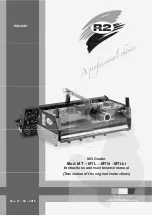
16
Automated Thermal Block
Cleaning and Decontaminating the Thermal Block
Cleaning the Thermal Block
•
Do not attempt to clean the thermal block or metal tube holder when they are hot.
•
Remove dust and debris by wiping the instrument surfaces with a lint-free cloth.
•
Wipe all spills or condensation with a soft cloth or paper towel, if needed.
•
If needed, the casing can be wiped off with a damp cloth using mild soap or detergent.
•
Do not use solvents or cleansers containing iodine or acetone, as these solutions could
damage the paint or display window of the block.
Decontaminating the Thermal Block
If contamination should occur, the following steps can be performed under sterile conditions to
help remove the contaminants.
•
Wipe the surface of the thermal block unit with a cloth dampened with 20% bleach
solution*, followed by a 70% ethanol rinse to prevent damage to the equipment.
•
Soak metal tube holders in 20% bleach solution* for about 5 minutes, then rinse
thoroughly with water and allow to air dry.
* An alternate cleaner designed to remove free DNA may also be investigated. A 10% bleach solution may also be used
for decontamination in accordance with your laboratory SOP but may require repetition of the cleaning to ensure the
removal of all amplicons.
Calibrating the Thermal Block
The Automated Thermal Block should not require calibration when used as directed. If your
laboratory requires calibration as part of your standard operating procedures, you can use the
following procedure to calibrate the block to the nearest degree.
Materials
•
Resistance Temperature Detector (RTD) thermometer with microprobe - VWR #61220-
601 or equivalent
•
Cluster tubes used for lysis (at least 48)
Note: If an RTD thermometer is not available, a dry bath alcohol thermometer (VWR #89095-782 or
equivalent) may be used to perform the calibration. However, because results may be less accurate due to
Summary of Contents for DUP-1000
Page 1: ...Model DUP 1000 User Guide...








































